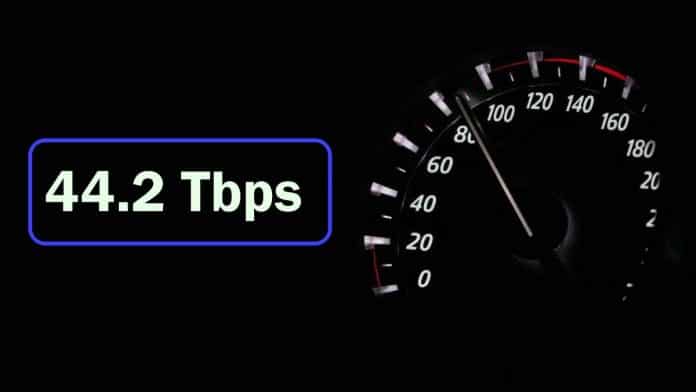A group of researchers in Australia claim they have successfully achieved the fastest Internet data speed ever, capable of downloading 1,000 HD movies in a split second using a single optical chip.
The research team led by Monash University’s Dr. Bill Corcoran, RMIT’s Distinguished Professor Arnan Mitchell, and Swinburne’s Professor David Moss recorded a data speed of 44.2 Terabits per second (Tbps) from a single light source.
With this speed, one can download 1,000 HD (720p) movies or more than 50 100GB Ultra HD (4K) Blu-ray discs in under one second.
The researchers used a “micro-comb” optical chip device that replaces around 80 lasers found in some existing telecommunications infrastructure used across Australia’s National Broadband Network (NBN).
Basically, the micro-comb, which is smaller and lighter than existing telecommunications hardware, is a laser source that acts “like a rainbow made up of hundreds of high-quality infrared lasers from a single chip”. Each ‘laser’ can be used as a separate communications channel.
The researchers tested the transmission on 76.6km of ‘dark’ optical fibres between RMIT’s Melbourne City Campus and Monash University’s Clayton Campus, according to an RMIT press release. This is known as the testbed.
According to the scientists, the fibre loop is part of the Australian Lightwave Infrastructure Research Testbed (ALIRT) established with investment from the Australian Research Council.
Researchers placed the micro-comb – contributed by Swinburne University – onto ALIRT’s optical fibres and sent maximum data down each channel, simulating peak internet usage, across 4THz of bandwidth.
While this micro-comb has been used within a lab-setting, this is the first time any micro-comb has been used in a field trial.
Experts say the discovery would help with increasing demand for remote work, streaming and socialising as well as could also probably be used in self-driving cars, medicine and education. It could help countries struggling with demand on internet infrastructure.
“We’re currently getting a sneak-peak of how the infrastructure for the internet will hold up in two to three years’ time, due to the unprecedented number of people using the internet for remote work, socializing, and streaming. It’s really showing us that we need to be able to scale the capacity of our internet connections,” said Bill Corcoran, co-lead author of the study and Lecturer in Electrical and Computer Systems Engineering at Monash University.
“It’s really showing us that we need to be able to scale the capacity of our Internet connections. What our research demonstrates is the ability for fibres that we already have in the ground, thanks to the NBN project, to be the backbone of communications networks now and in the future.”
He further added: “We’ve developed something that is scaleable to meet future needs. And it’s not just Netflix we’re talking about here – it’s the broader scale of what we use our communication networks for. This data can be used for self-driving cars and future transportation and it can help the medicine, education, finance, and e-commerce industries, as well as enable us to read with our grandchildren from kilometers away.”
Professor David Moss, Director of the Optical Sciences Centre at Swinburne University and another lead in the study, said in the 10 years since he co-invented micro-comb chips, they had become an extremely important field of research.
“It is truly exciting to see their capability in ultra-high bandwidth fibre optic telecommunications coming to fruition. This work represents a world-record for bandwidth down a single optical fibre from a single chip source, and represents an enormous breakthrough for part of the network which does the heaviest lifting. Micro-combs offer enormous promise for us to meet the world’s insatiable demand for bandwidth.”
RMIT professor Arnan Mitchell explained that the future ambition of the project was to scale up the current transmitters from hundreds of gigabytes per second towards tens of terabytes per second without increasing size, weight, or cost.
“Long-term, we hope to create integrated photonic chips that could enable this sort of data rate to be achieved across existing optical fibre links with minimal cost,” Arnan said.
“Initially, these would be attractive for ultra-high speed communications between data centres. However, we could imagine this technology becoming sufficiently low cost and compact that it could be deployed for commercial use by the general public in cities across the world.”
The results of the study were published in the journal Nature Communications on Friday.

